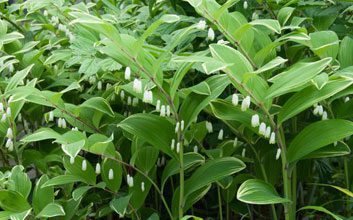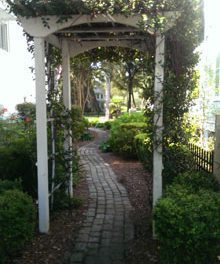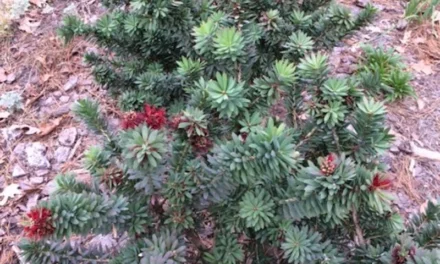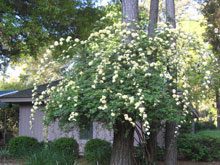 When the temperatures rise in the South there is only one place to be – in the shade. Since plants can’t get up and go to the shade, some of them would prefer being planted there in the first place.
When the temperatures rise in the South there is only one place to be – in the shade. Since plants can’t get up and go to the shade, some of them would prefer being planted there in the first place.
Choosing the right plant for a garden may require some trial and error. I have tried in vain to grow salvias in the shade, and they just don’t. I have much better luck with begonias, impatiens, and ferns, because my yard is mostly shade. Even shade lovers enjoy bright light. Variegated leaves can brighten up a dark garden corner. The native variegated Solomon’s Seal (below) is very pretty with its creamy stripes on small olive, green leaves. A variegated ground cover is strawberry begonia (above). Its pinkish-green leaves have soft hairs, and the delicate white blooms are charming on slender stems. A couple of other groundcovers that will take dry shade are Ajuga, green and gold, Japanese roof iris, and partridgeberry.
Moisture is necessary in the right amount. Many ferns grow in damp sites, but others like bracken and hart’s tongue can withstand dry shade. Asparagus ferns are downright drought tolerant and will grow in full sun or shade. Group plants together not only for their complementary colors, but more importantly for their water requirements. I was told to plant things near the birdbath if they liked a lot of water. Soaker hoses and drip irrigation are most helpful in getting the water to the roots of the plants without losing moisture to evaporation which is a problem with overhead sprinklers.
and hart’s tongue can withstand dry shade. Asparagus ferns are downright drought tolerant and will grow in full sun or shade. Group plants together not only for their complementary colors, but more importantly for their water requirements. I was told to plant things near the birdbath if they liked a lot of water. Soaker hoses and drip irrigation are most helpful in getting the water to the roots of the plants without losing moisture to evaporation which is a problem with overhead sprinklers.
The cast of shady characters is extensive in the coastal south, and many would argue that Camellia spp. is the leading lady playing many roles in various costumes. She can be grand or demure but always gorgeous. Early, mid-season, and late blooming, she wears costumes of blossoms that can range from pure white to red with an occasional yellow. In supporting roles are azaleas, winter Daphne, hydrangeas, and anise. Set designs by Mother Nature afford include vertical and horizontal elements and backdrops. Bark of the shade -providing trees is often interesting and some look like their trunks are decorated with remarkable colors and/or textures. Soil, mulch, grass, and low growing plants cover the floor of the stage. And the canopy of leaves and branches filter the light and produce interesting patterns and movement to the set. Sound and music play out in the shade garden as birds, crickets, frogs, and wind perform their songs, cheeps, chatter, splashes, and rustles.
Palms and gingers, ferns and annuals give an exotic feel to the garden and when cultivated in bright or low light settings add texture, color, variety and excitement. The large leaves of bananas and other tropical plants can be grown in large containers. House plants like orchids and bromeliads are perfectly happy to play “summer stock” outdoors in filtered light. The combinations and compositions of these plants create pure drama.
Bring your lawn chair, favorite beverage and enjoy the summer shade now showing in a garden near you.








